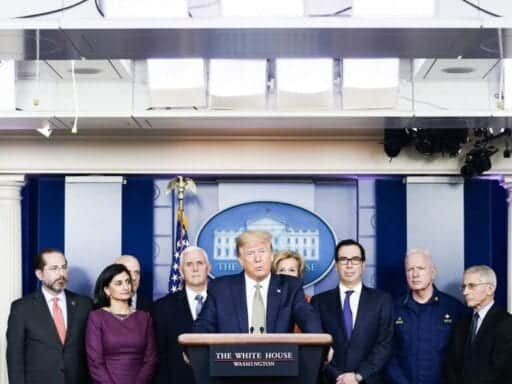The new guidance recommends social distance and good hygiene.
The White House released guidelines for the next two weeks for navigating the ongoing coronavirus pandemic on Monday, including the need to avoid gatherings of more than 10 people.
The guidelines stress the need for social distancing for all people, but especially for older and immunocompromised folks. The White House recommends that people listen to state and local authorities for specific guidance on how to deal with the outbreak of Covid-19, the disease caused by the novel coronavirus. But the unifying theme of the guidelines was to stay at home unless it’s absolutely critical.
Here are the specific groups of people they caution to stay home:
If you feel sick, stay home. Do not go to work. Contact your medical provider.
If your children are sick, keep them at home. Do not send them to school. Contact your medical provider.
If someone in your household has tested positive for coronavirus, keep the entire household at home. Do not go to work. Do not go to school. Contact your medical provider.
If you are an older person, stay home and away from other people.
If you are a person with a serious underlying health concern that can put you at increased risk (for example, a condition that impairs your lung or heart function or weakens your immune system), stay home and away from other people.
How to do social distancing, according to the White House
The guidelines also offer a bit of clarity around what social distancing looks like for young and otherwise healthy individuals.
As Vice President Mike Pence said at a press conference Tuesday, following the guidelines is critical to public health. “Our experts have told our task force that if every American acts on the president’s coronavirus guidelines, we could see a substantial reduction in the spread of the coronavirus,” he said.
Here’s how the White House recommends Americans do their part to slow the spread of coronavirus:
Work or engage in schooling from home whenever possible.
If you work in a critical infrastructure industry, as defined by the Department of Homeland Security, such as healthcare services and pharmaceutical and food supply, you have a responsibility to maintain your normal work schedule. You and your employers should follow CDC guidance to protect your health and work.
Avoid social gatherings in groups of more than 10 people.
Avoid eating or drinking at bars, restaurants, and food courts — use drive-thru, pickup, or delivery options.
Avoid discretionary travel, shopping trips, and social visits.
Do not visit nursing homes or retirement or long-term care facilities unless to provide critical assistance.
The guidelines also include recommendations about practicing good hygiene:
Wash your hands, especially after touching any frequently used item or surface.
Avoid touching your face.
Sneeze or cough into a tissue, or the inside of your elbow.
Disinfect frequently used items or surfaces as much as possible.
Flattening the curve
The White House guidelines stress the importance of social distancing. Social distancing is not a full quarantine, but it does mean limiting trips out into public to only those that are necessary. While out, people should maintain about six feet between themselves and others, according to experts, while taking care to maintain good hygiene, such as frequently washing hands.
Social distancing is important because preliminary research suggests about a quarter of all new coronavirus infections could be the result of asymptomatic transmission. That is to say, people could be carrying — and spreading — the virus even if they aren’t showing symptoms.
Experts have said these measures will help keep the health care system from being overwhelmed with cases of acute Covid-19, as explained by Vox’s Eliza Barclay and Dylan Scott:
Remember, America’s hospitals and doctors are already dealing with their usual caseloads during a pretty bad flu season. Now they have to be ready to handle any Covid-19 patients who come their way.
There are serious concerns about the US system’s capacity to handle a severe outbreak. Covid-19 is a respiratory illness and in its most serious stages can require patients with pneumonia to be put on a ventilator. But there might not be enough ventilators to meet that need if the outbreak becomes too widespread.
The Johns Hopkins Center for Health Security reported in 2018 that, according to US government estimates, about 65,000 people in the United States would require ventilation in an outbreak similar to the flu pandemics of 1957-1958 (which killed 116,000 people in the US) and 1968 (which killed 100,000 Americans).
The maximum number of ventilators that could be put in the field in the United States is about 160,000. So under those scenarios, there would theoretically be enough capacity to meet the need.
But if the coronavirus outbreak gets worse, we could quickly run out. In a situation more similar to the Spanish flu pandemic (675,000 dead in the US), about 742,500 people in the United States would require ventilation, according to government estimates. We don’t have that many.
The health system is much more than ventilators, of course, and the concerns about capacity apply to the rest of it, too. As HuffPost’s Jonathan Cohn reported, US hospitals have about 45,000 beds in their intensive care units. In a moderate outbreak, about 200,000 patients may need to be put in the ICU, but under a more severe outbreak, it could be nearly 3 million.
After a weekend of ongoing activity in many cities, people seem to be starting to pay attention to the pandemic this week. The White House guidelines provide a basic framework for people to follow as America continues to deal with the pandemic.
Author: Katelyn Burns
Read More



